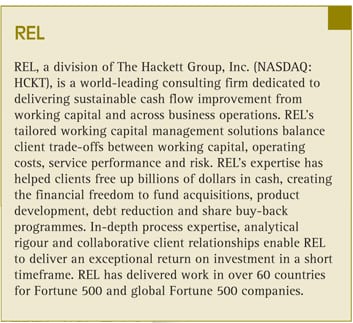After the Ballots
How the ‘year of elections’ reshaped treasury priorities
Published: February 01, 2014


Public companies often make a ‘dash for cash’ at the end of the fiscal year to produce a cash flow statement that’s suitable for framing when financial statistics are due to be released. They spend an enormous amount of effort trying to meet estimates of yearly performance and there is more at stake than mere window dressing. Beat expectations and investors reward you. Fall short and so will your stock price. The pressure to perform is so intense that many companies now game the system on an annual basis to make their numbers – especially working capital numbers – look good at year-end.

Game 1: Plump sales
To hit their revenue numbers, many companies resort to a variety of tactics to give their sales a temporary boost, offering customers discounts to encourage them to purchase more or bulk-buy. While this raises revenue it also hurts gross margins and profitability. The sales force often implements this tactic without completely understanding the company’s capability to produce the product, possibly creating a strain on manufacturing or supply chains as it tries to meet this artificial demand.
This also trains buyers to behave opportunistically – if discounts become a yearly habit, customers learn to postpone their buying until the offer comes round again.[[[PAGE]]]
Game 2: Step up collections
Receivables performance at year-end can be improved by sharpening focus on collections. Cash targets are set and collectors are given incentives to promote increased collection activities. Without the standard processes and procedures in place to optimise collections and receivables performance, actions like these tend to be a symptom of panic rather than standard operating processes.
The damage is not just financial. Increased collection activities can also give customers the idea that the company is strapped for cash, creating a perception of weakness that can easily become a reality if fearful customers begin to take their business elsewhere. Customers can also get weary of strong-arm techniques and look for alternative suppliers.
Game 3: Push out payments to suppliers
Intentionally withholding payments to suppliers enables companies to hang on to their cash a little longer. Saying “we have not received your invoice,” or “the cheque is in the post,” for example, are common ways to delay payments to suppliers but this is entirely short-term thinking. Not only are the potential benefits not sustainable, but they also risk affecting supplier relationships or worse, force them into financial distress, causing great harm to the entire supply chain.
Game 4: Delay receipt of goods and cleaning out of order book
Whilst trying to speed up sales near the end of the reporting period, companies also try to slow down or stop receiving any materials from their suppliers as a way to delay payment into the next year. At the other end of the scale, they also bring forward orders from the next period to clear out inventory from the books.
Not only can this can create problems for suppliers who cannot clear the inventory off their books, their cash flow is also hurt, as often it’s not made clear when they can expect the next payment for the shipment. Your own production schedules may also be disrupted and manufacturing losses increase because the company must run a suboptimal schedule.
Game 5: Run plants to full capacity whether or not the inventory is needed
This only applies to manufacturing plants, which are measured on utilisation and equipment absorption rates. At reporting period ends, companies sometimes make a conscious decision to run plants to full capacity to improve numbers, demonstrating operational efficiency and effectiveness to analysts. Of course, generating this false sign of health can have terrible side effects, such as a need for increased raw material inventory. Extra inventory produced may lead to obsolescence and write-offs.
The thing about all of these tactics is that they do work – at first: delaying payments to suppliers, reducing stock levels and increasing collections all make working capital look better for a little while. Unfortunately, as the points above show, most of those gains don’t usually last as long as even the next quarter.
If this were a harmless distraction, like the annual Christmas party, it might be a tolerable waste of time and effort. But typically, as after a crash diet, the lost weight returns with a vengeance. Companies begin the year contemplating a dismal set of metrics – and the need to begin reducing appears all over again. And, as we have seen, such quick cash fixes are frequently harmful. They are often stressful to the organisation, harmful to customer service and supplier relationships, and even damaging to long-term profitability.
Ironically, the amount of time, effort and money that companies invest in this practice every year-end far surpasses the effort to establish processes and procedures that, when run efficiently, help create conditions for working capital performance that would minimise and probably eliminate the need to play these games.
It doesn’t have to be this way because it is possible to make a dash for cash in a deliberate and considered way that allows the company to take working capital off and keep it off.
The key to making a sustainable dash for cash is to focus on the underlying processes that reduce working capital efficiency. With this in mind, here’s the ten-step programme to working capital success:
1. Ensure that collectors focus on the right customer accounts and employ strategic collection techniques – with the correct supporting measures and cash targets in place. Companies should invest in creating an overall customer-to-cash process, complete with standard processes and procedures. Developing, for instance, a long-term targeted collections strategy that changes only according to measurable improvements in customer behaviour.
2. Remove customer excuses for withholding payment by reducing the number of disputes and deductions caused by internally controllable issues such as pricing, discount, substitution and quantity errors.
3. Carefully analyse and align payment terms for key customers on a case-by-case basis.
4. Adjust payment terms and payment performance with vendors to ensure increased cash flow and compliance. Establish clear rules and play by them. If cash conservation is paramount at certain times, introduce flexible payment terms options, such as dynamic discounting or supply chain finance, that would allow your focus to tilt between working capital and gross margin improvement at any given time, without affecting crucial supplier relationships or jeopardising the financial health of their supply base.
5. Revamp payment routines. Eliminate early payments to increase payment efficiency, and penalise vendors for poor process compliance in order to increase cash flow generation and process efficiency.
6. Review inventory policies for key fast-moving seasonal items to ensure that excess stocks are reduced by year end.
7. Ensure that year-end plans take into account Q1 needs and offer customers the option to accept year-end deliveries to maximise sales potential while reducing buffer inventory.
8. Understand which products are slow-moving and at risk of obsolescence sooner so the inventory can be sold earlier, which minimises the value of stock write-downs.
9. Link quantified functional performance measures and targets directly to year-end corporate working capital targets and identify the levels of monthly incremental performance needed to meet goals.
10. Check to be sure that an effective form of transactional reporting exists that can truly monitor the impact of working capital decisions in the front line of the business, allow management to see the effects of working capital process changes, and ensure that the changes are sustained.
Executed correctly, not only will these ten steps produce quick results but they will also act as a foundation for lasting working capital excellence. Functions will begin to align more effectively, staff behaviours will change permanently, supplier and customer habits will alter, and key indicators will start to look more favourable. By following such a programme, companies can meet short-term objectives even as they lay the foundation for a longer-term sustainable change.
The devil is in the details, however, and these ten steps must be executed with precision and experience. Calculating the gap between existing performance and a corporate target is not enough. Companies require expertise to analyse inventory, accounts receivable, and accounts payable processes and performance, and identify and quantify the improvement opportunities. It’s also critical to have a detailed implementation road map that allows scarce resources to be focussed on the areas with the quickest potential for the greatest return.
Manipulating working capital numbers is expensive, hugely distracting and often harmful to the company, its customers and its suppliers. It’s far more productive to make structural changes that will steadily improve performance throughout the year – the kind of progress investors care about most. Warren Buffett’s mentor, Benjamin Graham, once stated, “In the short run the market is a voting machine, but in the long run it is a weighing machine”. Gaming metrics to beat analysts’ short-term expectations may plump returns in time for the new year – but only genuine improvements are rewarded in the long run.

More information on REL is available: by phone at +44 20 7398 9100; by e-mail at [email protected]; or on the web at www.relconsultancy.com.